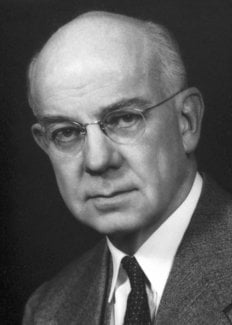Edward C. Kendall
Biographical

Edward Calvin Kendall was born on March 8, 1886, at South Norwalk, Connecticut, U.S.A. He was educated at Columbia University, where he obtained the degrees of Bachelor of Science in 1908 and Master of Science, specializing in Chemistry, in 1909. From 1909 until 1910 he was Goldschmidt Fellow of this University, and in 1910 he obtained his Ph.D. in Chemistry.
From 1910 until 1911 he was research chemist for Parke, Davis and Co., at Detroit, Michigan, U.S.A. Here he did research on the thyroid gland, and from 1911 until 1914 he continued this work at St. Luke’s Hospital, New York.
In 1914 he was appointed Head of the Biochemistry Section in the Graduate School of the Mayo Foundation, Rochester which is affiliated with the University of Minnesota, and in 1915 he was appointed Director of the Division of Biochemistry there and subsequently Professor of Physiological Chemistry. On April 1, 1951, Kendall reached the age of retirement from the Mayo Foundation and he accepted the position of Visiting Professor in the Department of Biochemistry at Princeton University, a position, which at the time of writing, he still holds.
Kendall’s name will always be associated with his isolation of thyroxine, the active principle of the thyroid gland, but he is also known for his crystallization of glutathione, the chemical nature of which he established, and also for his work on the oxidation systems in animals. Perhaps his greatest achievement, however, was his work on the hormones of the cortex of the adrenal glands. Chemical investigation of the adrenal cortex was carried out simultaneously but independently by Kendall and T. Reichstein with their associates. The former at the Mayo Foundation, Rochester, Minnesota; the latter at Zurich, Switzerland.
After many years the hormones of the adrenal cortex were isolated, identified, and prepared by synthetic methods in small amounts. Subsequently, they were made commercially on a scale sufficiently large to permit a study of their physiological effects. Previous to this, Dr. Philip Hench, also at the Mayo Foundation, had observed that patients who had rheumatoid arthritis were sometimes relieved if they developed jaundice. In women, rheumatoid arthritis was sometimes relieved during pregnancy. When one of the hormones of the adrenal cortex was given to patients by Dr. Hench, the anti-inflammatory effect of the compound, cortisone, was discovered. It was then found that many other diseases of an inflammatory nature were relieved by cortisone. Although it was found later that cortisone, like insulin, acts only so long as it is given to the patient, and that it does not cure the disease, the discovery of the activity of cortisone was a great step forward. It has led to our modern knowledge of the hormones of the adrenal cortex and their uses in medicine. For their work, Kendall, Hench, and Reichstein jointly were given the Nobel Prize for Physiology and Medicine for 1950. Since his retirement to Princeton University, Kendall has continued his studies of the chemistry of the adrenal cortex.
Kendall received many awards and other honours, some of these (Lasker Award of the American Public Health Service, Passano Award of the Passano Foundation in San Francisco, and Page One Award of the Newspaper Guild of New York) jointly with Dr. Hench. On December 1915, he married Rebecca Kennedy; they have two children.
This autobiography/biography was written at the time of the award and first published in the book series Les Prix Nobel. It was later edited and republished in Nobel Lectures. To cite this document, always state the source as shown above.
Edward C. Kendall died on May 4, 1972.
Nobel Prizes and laureates
Six prizes were awarded for achievements that have conferred the greatest benefit to humankind. The 12 laureates' work and discoveries range from proteins' structures and machine learning to fighting for a world free of nuclear weapons.
See them all presented here.
